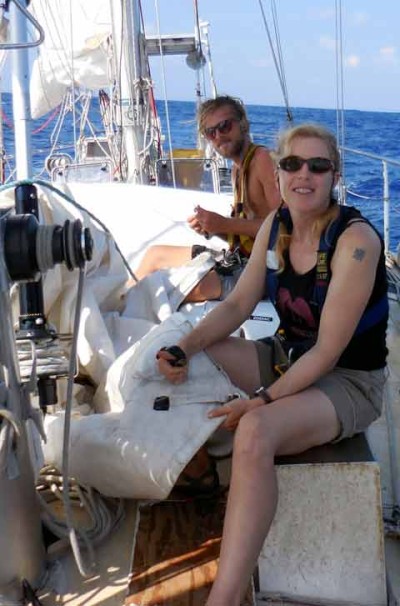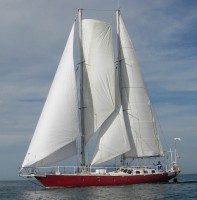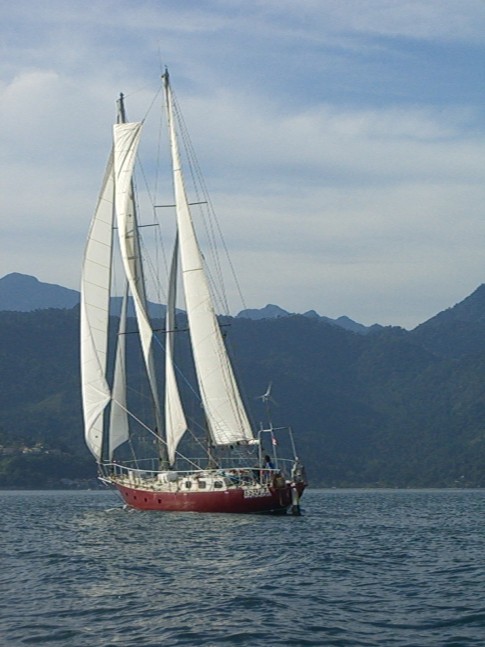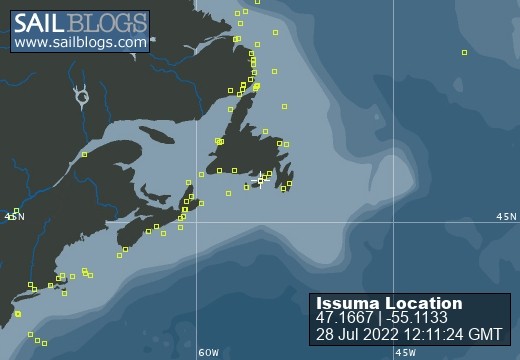
Issuma
28 July 2022
28 July 2022
08 May 2022
18 April 2022
07 April 2022
04 March 2022
17 February 2022 | Little Bay, Marystown, Newfoundland, Canada
16 February 2022
09 February 2022
06 February 2022 | Little Bay, Marystown, Newfoundland, Canada
05 February 2022 | Little Bay, Marystown, Newfoundland, Canada
01 February 2022 | Little Bay, Marystown, Newfoundland, Canada
30 January 2022 | Little Bay, Marystown, Newfoundland, Canada
25 January 2022 | Little Bay, Marystown, Newfoundland, Canada
24 January 2022 | Duricle Cove
17 January 2022
11 September 2021 | Little Bay, Marystown, Newfoundland, Canada
27 August 2021 | Grey River
26 August 2021 | Grand Bruit
26 July 2021 | Isle Valen
Mid Pacific Work Party
02 January 2015 | 18 47'S:117 44'W,
Maggie

One very pleasant afternoon recently we all spent some time on deck doing maintenance. Richard cut a section from an old dockline and made it into a rubrail for the dinghy in the background. Max and I repaired the voile d'etai, or main staysail, pronounced stays'l in English conversation. But if you didn't already know, Issuma is French built, and retains some of that joie de vive in her rigging. (Sorry I don't really know any French myself.) So in addition, the fore stays'l is known as the trinquette.
Both the trinquette and the voile d'etai are good storm sails, working hard and in harder conditions. So this sunny afternoon was a perfect time to have the voile d'etai down on deck for some care. Max sewed up loose seams, and in one place re-covered the wire that shapes the leech, or back of the sail. Sail theory says a lot of sail power comes from the leech, so retaining it's shape and integrity is important. I re-attached the webbing that provdes an extra layer of security at the clew, which is the lower back corner of the sail. The sheets, the lines that control the sail to the wind, attach here and this point carries significant strain. Sailmakers add reinforcement at the clew, and maintaining that will keep the sail fit for heavy weather. I don't have special training in sail repair, but luckily, the ship's library has some great reference books and the ship's work bench has the tools. In addition to a larger needle and thicker thread, I used a "palm," which is a leather band around your hand with a large metal disk at the palm. The metal disk is patterned like a thimble to aid you in pushing the needle through the layers of sailcloth and webbing. I really felt like a pro when I had pliers handy to pull the needle out the other side - a tip I had just read. I attempted a box and X stitch found in the research, but mine was no where near as neat as the photos in the book. My excuse being I was not in a stable sail loft ashore - I was up and down the waves on a mid Pacific work party!
Both the trinquette and the voile d'etai are good storm sails, working hard and in harder conditions. So this sunny afternoon was a perfect time to have the voile d'etai down on deck for some care. Max sewed up loose seams, and in one place re-covered the wire that shapes the leech, or back of the sail. Sail theory says a lot of sail power comes from the leech, so retaining it's shape and integrity is important. I re-attached the webbing that provdes an extra layer of security at the clew, which is the lower back corner of the sail. The sheets, the lines that control the sail to the wind, attach here and this point carries significant strain. Sailmakers add reinforcement at the clew, and maintaining that will keep the sail fit for heavy weather. I don't have special training in sail repair, but luckily, the ship's library has some great reference books and the ship's work bench has the tools. In addition to a larger needle and thicker thread, I used a "palm," which is a leather band around your hand with a large metal disk at the palm. The metal disk is patterned like a thimble to aid you in pushing the needle through the layers of sailcloth and webbing. I really felt like a pro when I had pliers handy to pull the needle out the other side - a tip I had just read. I attempted a box and X stitch found in the research, but mine was no where near as neat as the photos in the book. My excuse being I was not in a stable sail loft ashore - I was up and down the waves on a mid Pacific work party!
Comments
| Vessel Name: | Issuma |
| Vessel Make/Model: | Damien II, 15m/50' steel staysail schooner with lifting keel |
| Extra: | Designed for Antarctica. Built in France by META in 1981. Draft 1.3m/4.5' with keel up, 3.2m/10.5' with keel down. More details at http://www.issuma.com/rhudson/issumaboat/IssumaDetails.htm |
| Home Page: | http://www.issuma.com/rhudson/ |
| Social: |



